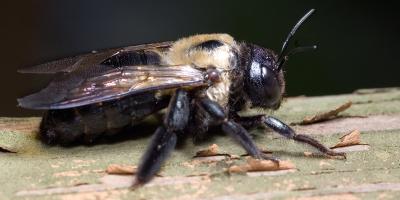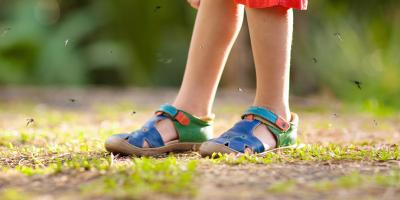Cicada Killer Wasps in the Schoolyard

As the dog days of summer begin to peak, so too does the population of a beneficial insect
whose reputation precedes it thanks in larger part to its killer name. Cicada killer wasps emerge from the ground having reached their adult stage sometime in July and can lurk in and out of underground burrows throughout New England until September. In other words, right through the beginning of the new school year.
Although cicada killers can and do sting humans, compared to other, more aggressive kinds of wasps and other stinging insects, cicada killers are generally a pretty docile species. The males are territorial and can appear a bit intimidating, but they lack stingers. And females usually won’t sting unless directly handled, so they aren’t to be feared, either.
Unless, of course, you’re a cicada.
Cicada Killer Wasps 101
What’s remarkable about these wasps with killer reputations is that the females of the species don’t kill cicadas to feed themselves -- adult cicada killers dine on nectar, mostly. Nor, of course, do they do it for sport. Cicada killer parents don’t actually kill cicadas at all -- in fact, they leave that up to their kids. Sort of.
Here’s how it works: First, the female wasp paralyzes a cicada with her venom and takes it back to her underground burrow. She then uses her stinger to inject a single egg inside the cicada, to be used as a live incubator of sorts until it is ready to hatch. After it finally does hatch, however, things don’t get any easier on the cicada… after digging itself out of the unwilling host, the wasp larva will then feed on the still-live cicada over the following weeks, then finally spin a cocoon from whence it will emerge as an adult cicada killer wasp the next season.
After feeding all August and some of September, cicada killer larvae overwinter underground. There is only one generation of cicada killer wasps per year, so once this season’s adults all die off and their young hunker down for the winter, we won’t see them again until the following summer.
Because they can easily frighten people, it’s important to be aware of cicada killers’ presence, especially on school grounds. The first step, then, is to know how to identify them.
Growing up to two inches in length, cicada killer wasps are quite big, with huge jaws to match. Their glossy black bodies are streaked in yellow, giving them that classic stinging insect look. They can often be found flying in and out of their elaborate underground bunkers, which the females build to use as a nursery.
Keep Out Cicada Killers
Because they are considered a beneficial species, treatment to rid the area of cicada killer wasps is typically not recommended. But that doesn’t mean you can’t take a few measures to make your school grounds less attractive to them. Especially as they can do a number on green spaces, with all those underground caverns.
Here are a few non-chemical preventative measures you can take:
- Water and fertilize your grass to help create a lush, thick turf that is too much trouble for cicada killers to tunnel through.
- Cover or fill wasp holes with mulch to block their entrance and exit.
- Water frequently – cicada killers prefer drier soil.
Don’t let hornets or wasps kill your fun this summer. If you’ve got a problem with summertime stingers, check out our page on wasps and hornets and contact us for a free quote today.



